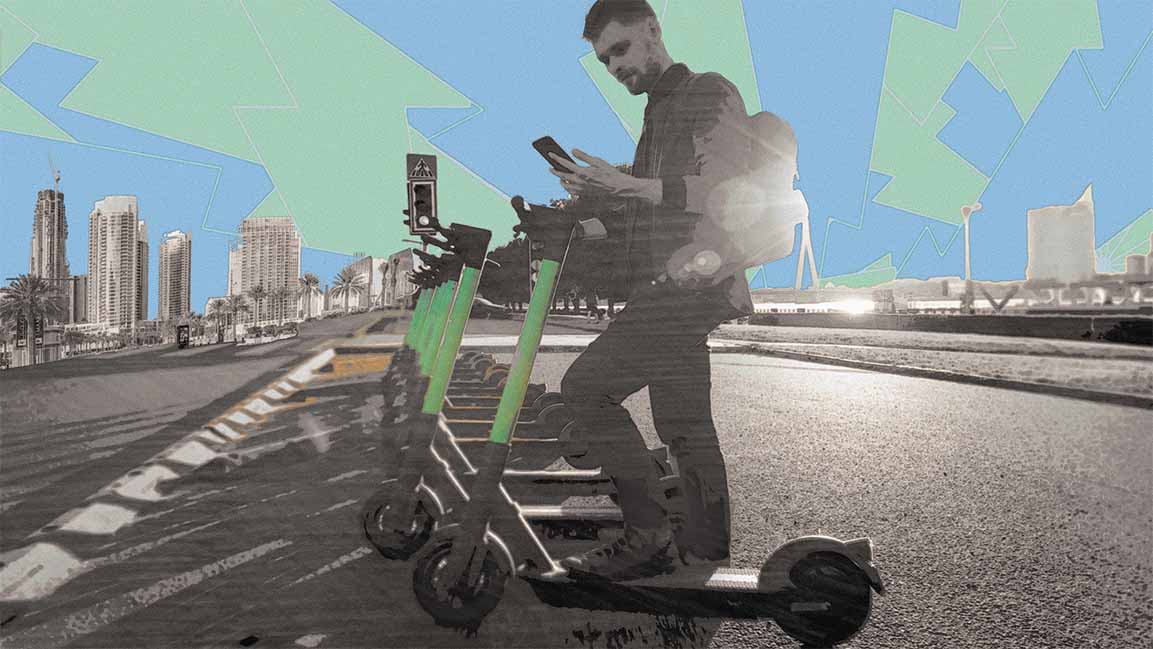- | 9:00 am
Why are e-scooters popular? How micro-mobility is booming in the Middle East
E-scooters offer MENA consumers an alternative for shorter trips and public transportation, all while being environmentally friendly.

Would you rather sit in traffic or feel the breeze in your hair while arriving at your destination at the same time, or maybe even faster?
Micro-mobility, such as e-bikes and e-scooters, in the Middle East, is gradually having its moment. And whether you love them or hate them, e-scooters have slowly become something of a fixture in Middle East cities.
The global e-scooter market was estimated at $33.18 billion in 2022 and is projected to register a compound annual growth rate of 9.9% from 2023 to 2030, according to Grand View Research.
E-scooters offer MENA consumers a promising fix for the MENA region’s surging private vehicle ownership and an alternative for shorter trips and public transportation while being environmentally friendly.
In Dubai alone, shared e-scooters made about one million trips in 2022. This is double the number recorded in 2021, which amounted to 500,000 trips, the Road and Transport Authority (RTA) reported.
INFRASTRUCTURE AND REGULATIONS LEAD THE WAY
Traditionally car-centric, cities have welcomed e-bikes and e-scooters, encouraged by suitable infrastructure and government-led initiatives to promote sustainable mobility.
In 2021, Dubai announced its Bicycle-Friendly City Strategy 2025 to support flexible means of transportation, with a total investment of approximately $108 million. Dubai’s RTA also lifted its ban on e-scooters and e-bikes on the condition of requiring e-scooter riders without a driving license to complete an online safety course for which they receive a permit. This has enabled (and encouraged) global and local players alike to enter the MENA micro-mobility landscape.
US-headquartered Lime launched its MENA operations in 2019, starting in Abu Dhabi, followed by Dubai and Doha. There’s considerable interest in micro-mobility from the UAE, says Mohamed Abouhussein, Lime’s General Manager for MENA, as UAE aims to reduce city traffic congestion. “The Middle East is adopting shared e-scooters and e-bikes faster than most, evidenced by how fast they transitioned from pilots to full-scale programs with competitive tenders in Abu Dhabi and Dubai.”
Having the right infrastructure for micro-mobility users is the number one factor influencing feelings of safety, says Amir Melad, General Manager – Middle East of TIER Mobility. The Germany-headquartered venture launched in 2020 in UAE, followed by Qatar and KSA. “Infrastructure which enables cyclists and micro-mobility users to be segregated from motorists was three times more likely to be chosen compared to other safety measures, including driver education, rider training, and wearing a helmet,” says Melad.
Another vital reason for its rising acceleration is high population density and high congestion levels in urban cities wherein commercial and residential locations are close to each other, making riding e-scooters and e-bikes convenient.
This was certainly the case for Kamal ElSoueni, co-founder and CEO of Rabbit Mobility, an Egypt-based micro-mobility startup. ElSoueni explained that the lack of viable transportation solutions for short distances in Egypt prompted the founder to offer the market an alternative. “According to data from ride-hailing apps and government stats, 50% of car trips done in Egypt are for a distance less than 3 kilometers, and 70% are for a less than 8 kilometers trip.”
According to ElSoueni, Rabbit’s vehicles have been used 1.5 million kilometers and have saved around 100,000 kgs of carbon emissions. Starting in 2022 with 18,000 users, the venture’s users skyrocketed to 300,000.
The onset of the COVID-19 pandemic also changed the way we get to work and go around cities. TIER’s Melad noted that usage spiked during the pandemic and has continued to affect behavioral patterns in the post-pandemic world. Especially for short distances, customers have chosen micro-mobility solutions, as both higher petrol prices and the convenience of door-to-door transportation offered a real benefit to consumers while contributing to a cleaner city. It’s a welcoming note since globally, the onset of the COVID-19 crisis brought a decline in micro-mobility solutions dramatically, according to a report by McKinsey.
TACKLING HURDLES
While the perception of micro-mobility vehicles was positive, ElSoueni says that in Egypt, a key challenge in 2020 was how it’s used for fitness and leisure, but not for transport. The team focused on education and awareness campaigns to encourage consumers to use it as an alternative transport. As a result, as of the end of 2022, ElSoueni says that from their user survey of 25,000 users, 65% of rides done by Rabbit vehicles are not for fitness or leisure.
Though there’s progress in infrastructure for micro-mobility, there’s still a lot more to be done. What TIER does, Melad says, is work closely with real estate developers to create dedicated bike lanes and parking spaces.
As for what’s next in the micro-mobility scene, Lime’s Abouhussein points out, “Middle Eastern cities are planning for the future, and they increasingly recognize that people want to live and work in environments that aren’t completely dominated by hard-to-traverse highways and roads.”
Undoubtedly, cities in the MENA region are looking for ways to make their transport networks safer and more environmentally friendly. While it’s too soon to know if e-scooters will replace cars in the MENA region, it holds significant potential to offer mobility options in cities to reduce congestion and pollution.








































